The upright bass gives off a deep, warm sound that fills the room like a cozy blanket on a cold night. Its tones reach down low and vibrate through your chest, making you feel the music in your bones. Many jazz and blues musicians swear by its rich voice, and some even say it brings songs to life in a way electric bass just can’t match. If you want to explore the true heart of rhythm and soul, this instrument holds secrets that can transform any tune into something unforgettable. Keep reading to find out what makes the upright bass stand apart from the rest.
This unique timber of an upright bass makes it tricky to EQ and sit in mix.
In this article, well cover how you can EQ and mix your upright and double bass for a professional sounding mix.
EQing an Upright Bass
When it comes to equalizing an upright bass, it’s important to know what type of EQ to use.
Parametric EQs are often preferred for their precision and flexibility, allowing you to target specific frequencies and adjust the bandwidth (Q) of the EQ bands.
The timbre and character of an upright bass should guide your EQ decisions.
A well-recorded upright bass will have a natural, woody tone with a strong fundamental frequency and harmonics.
Your goal should be to enhance these desirable characteristics while minimizing any unwanted frequencies that may clash with other instruments in the mix.
🏆 Our Favorite Plugin for EQing an Upright & Double Bass
When you are working with upright basses, you tracks usually have a lot of dynamics in them from the bass and other instruments. Nothing handles these dynamics better and more precisely than Fab Filter Pro Q 3.
You can easily maintain clarity and presence in the mix with this award winning EQ. We’ve found the Pro Q 3 to be the best EQ for EQing upright & double basses.
Understanding the Upright Bass Frequency Spectrum

The upright bass covers a wide frequency range, typically from around 40 Hz to 2 kHz.
The fundamental frequencies of the upright bass strings lie between 40 Hz (E1) and 247 Hz (B2).
Key frequencies to focus on for EQ adjustments include the following
| Frequency Range | Description |
|---|---|
| 60-80 Hz | The low-end thump and weight of the bass. |
| 200-400 Hz | The body and warmth of the instrument. |
| 800 Hz-1 kHz | The attack and string noise. |
| 1-2 kHz | The presence and articulation of the notes. |
Step-by-Step Guide to EQ an Upright Bass
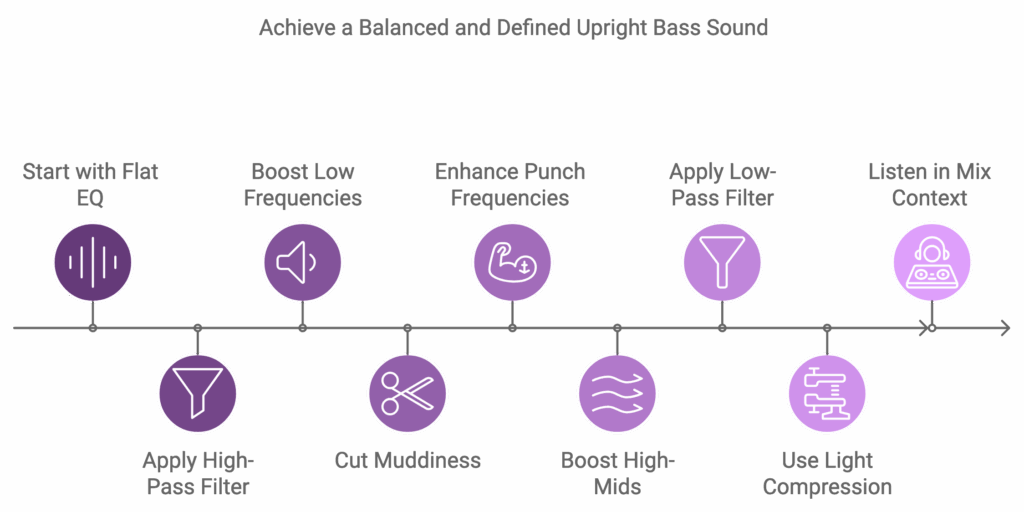
EQing an upright bass can be a nuanced process, as it depends on various factors such as the room, the mic, the other instruments involved, and the type of music.
Here is a step-by-step guide to help you achieve a balanced and defined upright bass sound.
1. Initial Setup
- Start Flat: Begin with all EQ settings flat. This means setting all EQ knobs to their neutral position (usually 0 or 12 o’clock) to hear the natural sound of the bass.
2. Low-End Management
- High-Pass Filter (HPF): Apply a high-pass filter to remove unnecessary sub-bass frequencies. Set the HPF around 60 Hz to 80 Hz to clean up the low-end rumble without affecting the fundamental frequencies of the bass.
- Boost Low Frequencies: If the bass lacks body, you can boost around 80 Hz to 200 Hz to add fullness and depth. Be cautious not to overdo it, as too much boost can make the sound muddy.
3. Midrange Adjustments
- Cut Muddiness: The 200 Hz to 300 Hz range can often introduce muddiness. Apply a gentle cut in this range to clear up the sound. This helps in making the bass more articulate and less boomy.
- Enhance Punch: For more punch and presence, consider boosting around 500 Hz to 1000 Hz. This range adds definition and helps the bass cut through the mix.
4. High-End Clarity
- Boost High-Mids: To add clarity and definition, especially to the attack of the notes, boost around 2.5 kHz to 5 kHz. This can help the bass stand out without sounding harsh.
- Low-Pass Filter (LPF): Apply a low-pass filter to roll off unnecessary high frequencies above 5 kHz. This helps in placing the bass in its own space within the mix and avoids competition with other midrange instruments.
5. Compression
- Light Compression: Use a compressor with a slow attack and moderate release to even out the dynamics without squashing the natural sound of the upright bass. Aim for around 4 dB of gain reduction.
6. Contextual Listening
- Mix Context: Always EQ the bass in the context of the full mix. Soloing the bass can be useful for identifying problem frequencies, but the final adjustments should be made while listening to the entire mix to ensure the bass fits well with other instruments.
7. Fine-Tuning
- Sweep for Problem Frequencies: Use a narrow Q and sweep through the frequency spectrum to identify and cut any resonant frequencies that cause issues like boominess or boxiness.
- Enhance Desired Frequencies: Similarly, sweep to find frequencies that enhance the character of the bass and apply gentle boosts as needed.
8. Final Adjustments
- Reverb and Effects: If desired, add a touch of reverb to give the bass some space and natural ambiance. Be subtle to avoid washing out the sound.
- Check in Different Listening Environments: Listen to the mix on different speakers and headphones to ensure the bass translates well across various playback systems.
By following these steps, you can achieve a well-balanced and defined upright bass sound that complements the overall mix. Remember, EQing is both an art and a science, so trust your ears and make adjustments based on the specific context of your mix.
EQ Techniques for Different Playing Styles
Bowed Upright Bass
- When EQing a bowed upright bass, focus on enhancing the richness and sustain of the notes.
- A gentle boost around 200-400 Hz can add warmth and body to the sound.
- Be cautious with high-frequency boosts, as they can emphasize unwanted bow noise.
Plucked (Pizzicato) Upright Bass
- For a plucked upright bass, you may want to emphasize the attack and percussive nature of the playing style.
- A slight boost in the 800 Hz-1 kHz range can help bring out the string attack and improve note definition.
- A dip around 200-300 Hz can help reduce any muddiness or boominess in the low-mids.
Genre-Specific EQ Settings
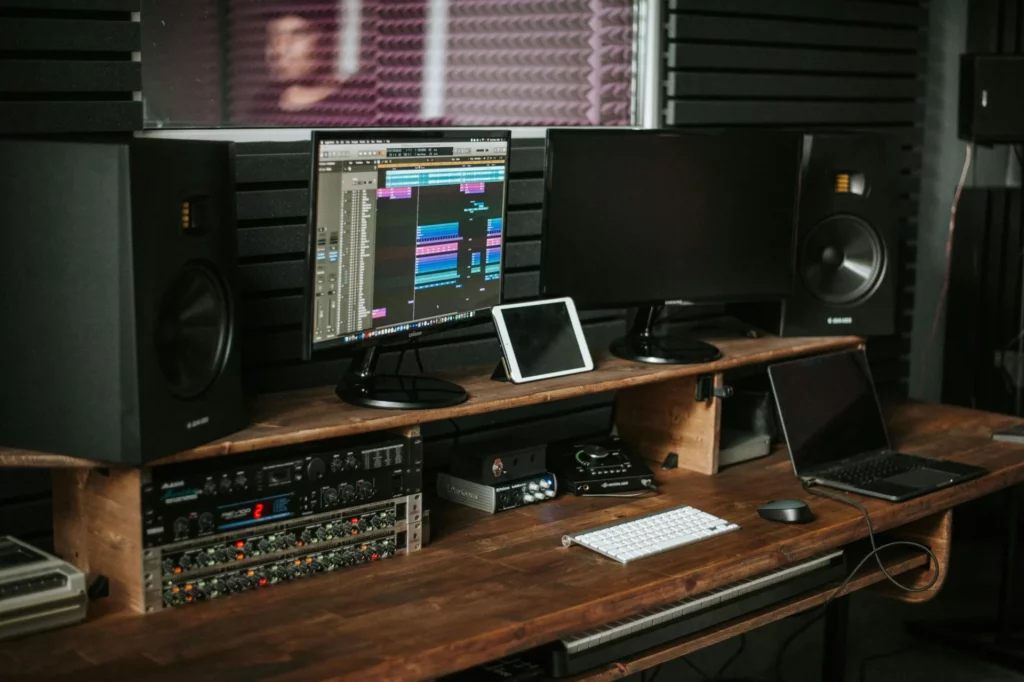
Classical
In classical music, the goal is often to capture the natural, acoustic sound of the upright bass.
Avoid excessive EQ adjustments and focus on subtle tweaks to enhance clarity and blend with the ensemble.
Jazz
For jazz, you may want to emphasize the warmth and resonance of the upright bass.
A gentle boost around 200-400 Hz can add body and depth to the sound.
Be mindful of the low-end, as too much bass can overpower other instruments in the mix.
Rockabilly and Psychobilly
In rockabilly and psychobilly genres, the upright bass often takes on a prominent, slap-heavy role.
A boost in the 1-2 kHz range can help accentuate the percussive slap and pop of the strings.
A slight cut around 200-300 Hz can help tighten up the low-end and prevent muddiness.
Electronic
When integrating an upright bass into electronic music mixes, you may need to make more aggressive EQ adjustments to help it cut through the dense arrangement.
A high-pass filter around 40-50 Hz can help remove any unwanted sub-bass frequencies that may clash with kick drums or basslines.
A boost in the 800 Hz-1 kHz range can help the upright bass maintain its presence and definition in the mix.
Advanced Upright Bass EQ Techniques
Blending with Other Instruments
To help the upright bass blend with other instruments, consider using complementary EQ curves.
For example, if you have a bass-heavy kick drum, you may want to slightly dip the upright bass around that frequency to avoid conflicts.
Similarly, if you have a piano or guitar occupying the mid-range, you can carve out some space for the upright bass by making subtle cuts in those instruments’ frequencies.
Dynamic EQ and Side-Chain Compression
Dynamic EQ can be a powerful tool for controlling the upright bass in a mix.
By setting a threshold and ratio, you can have the EQ only engage when the bass reaches a certain level, helping to maintain a consistent tonal balance.
Side-chain compression can also be used to duck the upright bass slightly when other instruments (like kick drums) are playing, preventing frequency masking and ensuring clarity in the mix.
🏆 Our Favorite AI Plugins for EQing an Upright Bass & Double Basss
Another killer EQ for your upright basses is an iZotope’s Neuron 4. This is an AI powered dynamics processor that has much more than an EQ in it.
Just click a button and you can get your upright bass mixed. It’s not 100% perfect and some adjusting needs to be done, but its an incredible starting point.
Its intuitive interface makes it easier for us to pinpoint and address problematic frequencies effectively.
Step-by-Step Guide to Mic Setup for Upright Bass
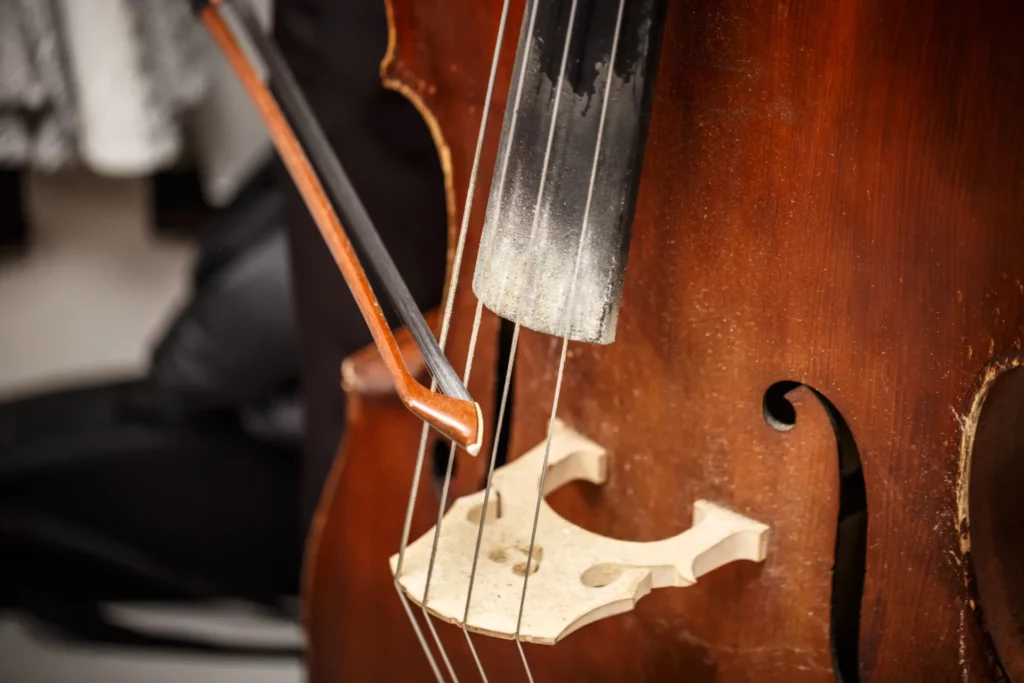
Its also important to note that you NEED a good recording of your upright bass in order to get a good mix.
EQing alone won’t save a bad recording of an upright bass.
Here is a quick step by step guide on how to mic an upright bass.
Choose Your Microphones
- Ribbon Mic (e.g., Rode NTR): Warm, natural sound.
- Large Diaphragm Condenser (e.g., Avantone CV-12): Detailed sound, wide frequency range.
- Specialized Condenser (e.g., Nadine by Ear Trumpet Labs): Designed for upright bass[1][2][10].
Mic Placement Techniques
- Ribbon Mic: Place about 6 inches below the bridge, pointing upwards[1].
- Condenser Mic in Omni Mode: 6-8 inches from the bridge for a balanced sound[1].
- Condenser Mic in Cardioid Mode: 6-8 inches from where the neck meets the body for clarity[1].
Dual Mic Setup
- Mic 1: Near the bridge for body and resonance.
- Mic 2: Higher up the neck for articulation[9][11].
Experiment with Distance and Angles
- Close Miking: 6-12 inches for a punchy sound.
- Distance Miking: 1-2 feet for more room ambiance[3][7].
Avoiding Proximity Effect
- Use omnidirectional mics to avoid low-end buildup[9].
Setting Up the Nadine Mic
- Mounting: Attach to the tailpiece, position between strings above the tailpiece.
- Connection: Use the 14-inch cable to connect to your recording interface[2][10].
Additional Tips
- Use a DI Box: Capture a direct signal for blending during mixing[7][9].
- Monitor with Headphones: Adjust mic positions for optimal sound[1].
Recording and Adjustments
- Test Recordings: Try different placements and settings.
- Adjust EQ and Compression: Balance frequencies and control dynamics as needed.
By following these steps, you can effectively capture the rich, full sound of an upright bass.
Common EQ Mistakes and How to Avoid Them
Over-EQing
One of the most common mistakes when EQing an upright bass (or any instrument) is over-EQing.
Avoid making drastic boosts or cuts, as this can lead to an unnatural, processed sound.
Remember that small, incremental adjustments can often make a big difference in the overall tonal balance.
Ignoring Phase Issues
When EQing an upright bass, be aware of potential phase issues that can arise from excessive EQ adjustments.
If you find that your EQ is causing the bass to sound thin or hollow, try using a linear-phase EQ or adjust the Q values of your EQ bands to minimize phase distortion.
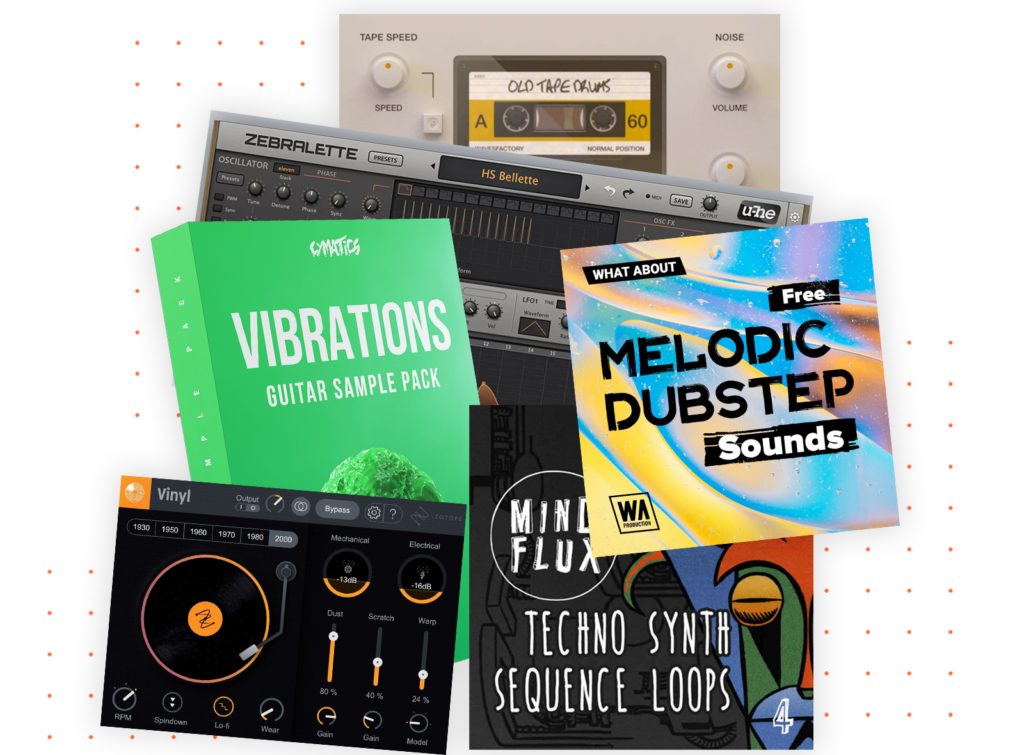
Access 4,000+ Music Tools
Access our entire library of music tools including sample packs, VST plugins, DAW templates, and much more.
Additional Resources For EQing an Double Bass and Mixing
To further your knowledge of EQing and mixing upright bass, consider exploring these resources:
- “Mixing Secrets for the Small Studio” by Mike Senior
- “The Mixing Engineer’s Handbook” by Bobby Owsinski
- “The Art of Mixing” by David Gibson
Case Studies and Examples
To illustrate the impact of EQ on an upright bass, let’s look at a few real-world examples:
“So What” by Miles Davis
In this classic jazz track, the upright bass has a warm, round tone that sits perfectly in the mix.
Notice how the bass has a strong presence in the low-mids (around 200-400 Hz) without sounding boomy or overpowering.
“Psycho” by The Sonics
This rockabilly-influenced track features an aggressive, slap-heavy upright bass sound.
The bass has a pronounced mid-range presence (around 1-2 kHz) that helps it cut through the distorted guitars and pounding drums.
“Limit to Your Love” by James Blake
In this electronic track, the upright bass is processed and manipulated to fit the sparse, atmospheric arrangement.
The bass has a tight, focused low-end (likely achieved with a high-pass filter) and a subtle boost in the upper mids to maintain its presence in the mix.
Final Thoughts
EQing an upright bass is a delicate balance of enhancing its natural, warm tone while ensuring it sits well in the context of a mix.
By understanding the frequency spectrum of the instrument, applying genre-specific techniques, and avoiding common mistakes, you can achieve a professional, polished sound.
Looking For a Library of Music Production Tools on a Budget?

SoundShockAudio has got you covered. Save time Googling for free tools and subscribe today and access our vast library of over 4,000 tools to create professional-sounding music.
Need more help when it comes to EQing?
Check out these articles:

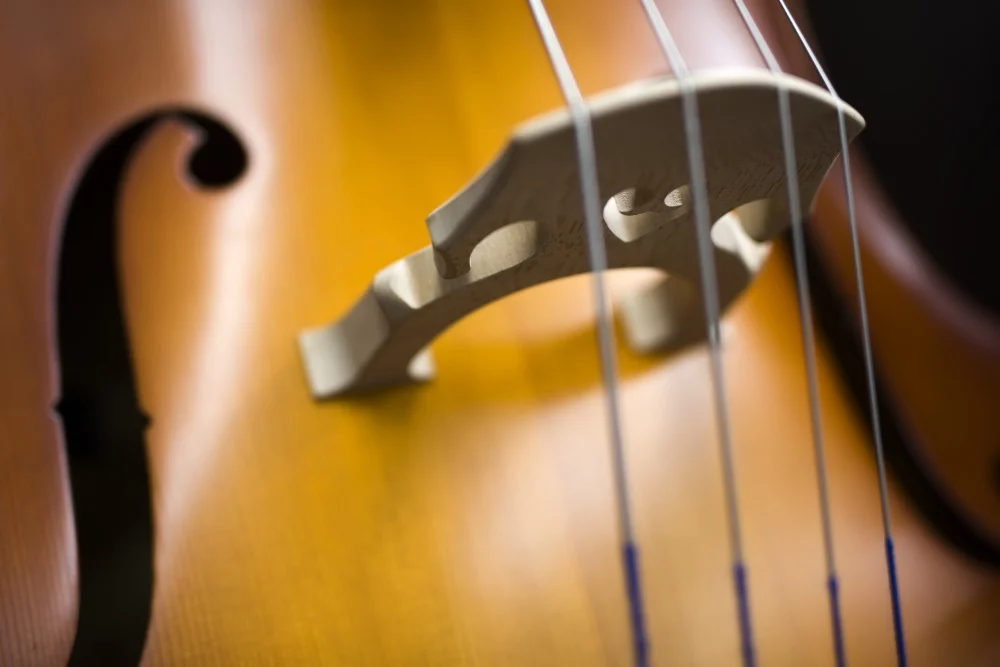



hey Daniel, got a question bout genre-specific eq settings. for jazz, do you think a warmer tone works better than a brighter one? always struggle to make the upright bass sit well in the mix.
The section on blending with other instruments was particularly enlightening. It’s fascinating to consider the dynamic EQ not just as a corrective tool, but as a creative one for enhancing musical collaborations across genres.
Absolutely agree, Bella. It’s an art to balance the distinct tonal qualities of an upright bass in such diverse settings. The EQ can indeed be a bridge between traditional and contemporary sounds.
Interesting points! Any plugin recommendations for someone just getting into this sort of audio manipulation?
tried the rockabilly eq settings you suggested but it just didn’t slap right. feels like it lacks that gritty punch, you know what i mean? maybe it’s just my gear.
Looking for a library of music production tools on a budget? Aren’t we all, Daniel, aren’t we all. Next you’re gonna tell me there’s a magic plugin that mixes for me.
Daniel, while the article provides solid advice on EQ techniques, I believe there’s a slight misconception about dynamic EQ and side-chain compression. They’re similar but serve distinct purposes. Dynamic EQs adjust frequencies selectively based on the signal level, offering more precision than side-chain compression, which typically ducks the volume of an entire track. Both tools are valuable, but understanding their differences is crucial for optimal use.
really dig the advanced eq techniques part. blending with other instruments using dynamic eq’s a game changer for my mixes. helps my bass lines weave in and out smoothly, especially in cluttered electronic tracks.
The article covers a broad spectrum of EQing techniques which is commendable. However, it might overwhelm beginners without additional context or foundational knowledge. Speaking from experience, a sequential guide might be more accessible.
Great, another set of EQ ‘guidelines’. Because, you know, what we all need is to sound exactly the same. Magic EQ settings, here I come!
Daniel, that jazz EQ section is spot on! Finally got my upright bass sounding just right in the mix. Those mids really do make all the difference. Cheers for the tip.